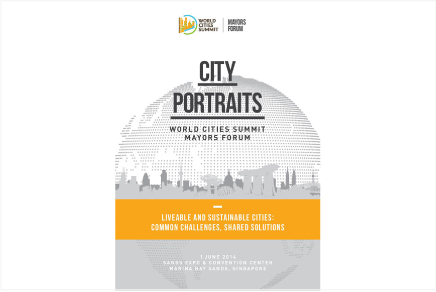Home >
ABOUT US >
Past Editions >
World Cities Summit 2014
World Cities Summit 2014
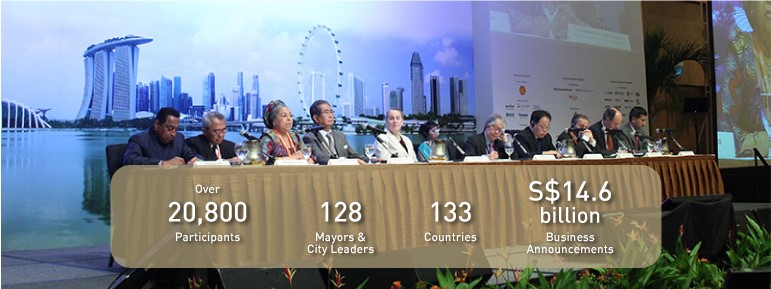
Cities are taking centre stage as key players in the future of human populations. This central role of cities for the future and exploring new ways forward was the theme at the 4th World Cities Summit (WCS) “Liveable & Sustainable Cities: Common Challenges, Shared Solutions”. The key takeaways were five areas of consensus, which pose challenges that cities need to address in order to move towards greater liveability and sustainability.
- Connectivity: The broadest of the five challenges includes connecting citizens and cities better through more collaborative initiatives and international networks such as the WCS, so that mistakes in city management are not repeated while good ideas and solutions can be replicated and customised for implementation in more cities. Drawing from networks will equip cities for longer-term challenges such as rural–urban migration and climate change.
- Technology: Finding the best ways to harness information and data more effectively with better technology can raise the quality of life in cities, especially when applied in areas such as enhancing the use of transport and urban mobility.
- Equity: Improving the living environment of cities would be incomplete without ensuring that the benefits of greater liveability can be accessed by all residents along the whole socio-economic spectrum, as well as across all ages and minority groups. Inclusive communities will build trust and ensure the sustainability of city developments.
- Engagement: Cities that succeed in managing urbanisation well will have to be more innovative and consultative, to reach out to their residents for ideas and really involve them. Beyond participation, residents can be encouraged to take ownership of, and improve, their environment and the community.
- Identity: As globalisation brings much change to cityscapes, heritage and culture will be an even more vital resource, valued by cities to remain unique and by residents to identify with their living environments. All the more, heritage and culture will need to be integrated well into urban development.
View Highlights of WCS 2014
MAYORS FORUM
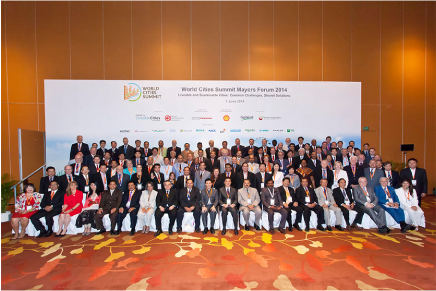
Putting people at the heart of cities was the central theme of the 5th annual WCS Mayors Forum. Among the common challenges, one common threat that delegates grappled with was the intensifying pace of urbanisation and rural-urban migration, which has further strained infrastructure and resources everywhere.
This is happening against a backdrop of the growing effects of climate change, as well as of other trends such as rapid ageing and a more affluent middle class that is more demanding of transparency, good governance and citizen participation in city planning and management.
To address the global challenges of enhancing city liveability, the first focus was seen to be engaging the community more so as to balance the needs of the larger whole against those of smaller groups such as entrepreneurs. New communication channels such as social media must be embraced to know what people really want, and better use of big data and technology can help acquire this knowledge and understanding. This will then help mobilise community response and collective wisdom.
To address the global challenges of enhancing city liveability, the first focus was seen to be engaging the community more so as to balance the needs of the larger whole against those of smaller groups such as entrepreneurs. New communication channels such as social media must be embraced to know what people really want, and better use of big data and technology can help acquire this knowledge and understanding. This will then help mobilise community response and collective wisdom.
View Mayors Forum 2014 Report
LEE KUAN YEW WORLD CITY PRIZE
LAUREATE CITY: SUZHOU
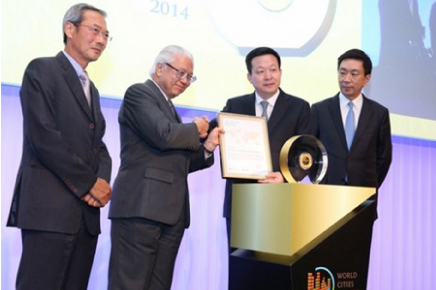
Suzhou was awarded the 2014 Lee Kuan Yew World City Prize. Suzhou has undergone remarkable transformation over the past two decades. The significance of its transformation lies in the city’s success in meeting the multiple challenges of achieving economic growth in order to create jobs and a better standard of living for its people; balancing rapid urban growth with the need to protect its cultural and built heritage; and coping with a large influx of migrant workers while maintaining social stability.
On the whole, the city leaders of Suzhou have demonstrated strong leadership and commitment to develop the city, guided by good governance and structured processes. The clearly articulated long-term vision and planning approach that Suzhou has put in place, combined with competent leadership and strong political support, have enabled the city to tackle urban challenges effectively. Suzhou provides many good lessons for the many rapidly urbanising cities in China as well as in other developing nations.
YOUNG LEADERS SYMPOSIUM
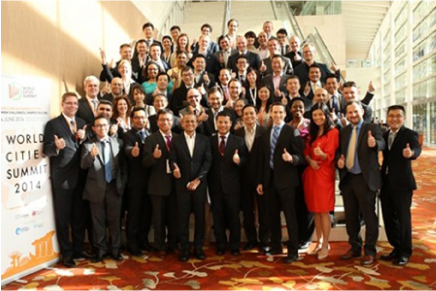
Themed “Seeding Change in my City”, the inaugural WCS Young Leaders Symposium in Singapore added a new and important dimension to the Summit—a new community of voices advocating for more liveable cities. Comprising young leaders aged between 30 and 45, the Symposium focused on identifying the structural changes needed, as well as the initiatives that have catalysed change in cities.
Key takeaways:
- Human relationships should be at the core of cities since people are the ultimate beneficiaries of liveability.
- Technology can enhance people’s lives and welfare and has a part to play in reducing social inequality.
- For true empowerment, trust must exist amongst people, and between people and government.
- There is no one-size-fits-all solution. Each city has different strengths, weaknesses and priorities, requiring understanding of their own special characteristics.
- A highly liveable environment is a key ingredient of a successful economy.
- Data availability, transparency and use can facilitate comprehensive city planning.
- Nurturing a distinct city identity and character can give a city a competitive edge.
- Cities must be a home to be embraced.
- Developing economic strengths and inclusivity should be planned in parallel.
- A good balance between competition and collaboration is essential for sustainable ways of city development.
THEMATIC TRACKS
Discussion 1: High Quality of Life: A Vibrant City
As more developed cities face greater demands for transparency and participation from a growing middle class, economic growth has to be more inclusive to overcome rising inequality of access and opportunity, especially with more migration.
- Common challenges: Building a deeper sense of belonging, passion and ownership of the city; dealing with growing income disparity and eliminating poverty; offering inclusive growth by addressing inequality; sustaining city vibrancy; managing multicultural diversity.
- Shared solutions: Involving people more in city management; investing more in education; ensuring minority communities are well integrated; boosting greenery and parks as “spaces that unify people”; have the government lead by example in public-private partnership projects; use big data to plan and manage city.
Discussion 2: Sustainable Environment: Water and Waste Management
With rapid urbanisation, cities are generating more waste and putting a strain on infrastructure and capacity for waste and water management. Efforts of conservation and restraint will go nowhere without the buy-in of long-time city residents and new migrants.
- Common challenges: Water conservation effects of climate change; building and maintaining segregated channels for clean water; greater energy efficiency; low recycling rate; high cost of doing nothing.
- Shared solutions: Integration in city planning of water management with other systems such as waste management; economic incentives and disincentives for good environmental practices; involving residents to reduce waste generation; more education for citizen participation; more sharing of limited resources and financing; more public-private partnerships for holistic solutions.
Discussion 3: Competitive Economy: Driving Investments
Balancing growth with sustainability gets tougher for cities as rural-urban migration and higher demands on resources and infrastructure increase. Cities need to continuously introduce innovations to sustain competitiveness in attracting investments.
- Common challenges: Balancing growth and urban management; issues arising from urban migration; managing land use conflicts; need for efficient water and energy consumption.
- Shared solutions: Prioritise the needs of residents; good master planning; having special economic zones.
Discussion 4: Integrated Long-term Planning: Balancing Stakeholder Interests
While the short political terms of mayors pose a major challenge to the need for longer-term planning, making a case for shorter timescales, this has to be weighed against the need to take in a longer time horizon to cater to a wider range of stakeholder interests.
- Common challenges: Building sustainable infrastructure for business, housing and transport; fostering a deeper sense of belonging and citizen participation in city development; shared financing between federal and city governments.
- Shared solutions: Making long-term plans flexible; ensuring a balance with social, cultural and environmental aspects of development; maintaining open communication channels with all stakeholders; enhancing the social fabric; shortening planning timescales to be more responsive to global change; applying technology well; more public-private partnerships.
Discussion 5: Dynamic Urban Governance: Fostering Good Governance
Governing a city well covers many dimensions and a dynamic urban governance is integrating successfully both the multiple vertical layers (of government) and the horizontal
layers (with stakeholders). Consultation, communication, coordination and cultivation are all vital elements that make up good governance.
- Common challenges: Coordinating multi-layer leadership; balancing between responding to citizens’ requests and sticking to strategic aims; drawing effective community participation; attracting the right talent mix.
- Shared solutions: Giving citizens a deeper sense of ownership; integrated long-term master plan co-created with public consultation; better communication using many vehicles; collecting good data to measure progress.
Discussion 6: Intelligent Cities
Information and data are becoming more important to the intelligence and responsiveness of a smart city. As the information revolution continues to empower citizens with more data and a louder voice, the demand on city authorities will increase. Technology can provide solutions to make cities safer, more resource-efficient and attractive to creative industries.
- Common challenges: Uncertainty over sharing of government data; balancing maintaining security and enforcing rules and giving a sense of freedom; managing ground resistance to smart city projects; getting the private sector on board; applying technology; involving and engaging the people better.
- Shared solutions: Applying data and technology to make a city more of a social being and for sustainable living; gain people’s support by showing tangible success; encouraging small and medium businesses, and young wealth creators; infrastructure investment; building connections to other cities; CCTVs used to maintain public safety; manning a command centre using technology.
